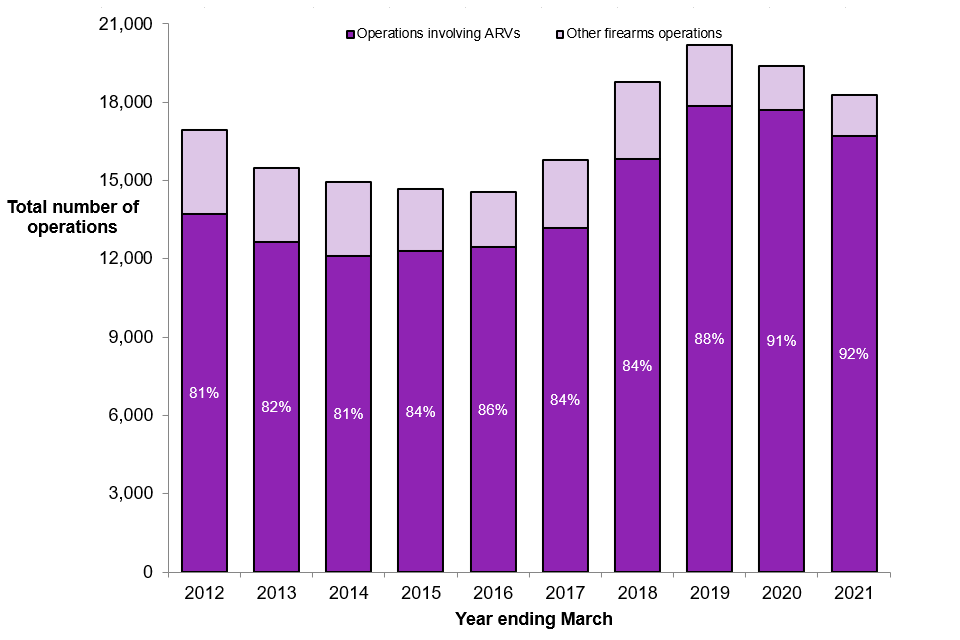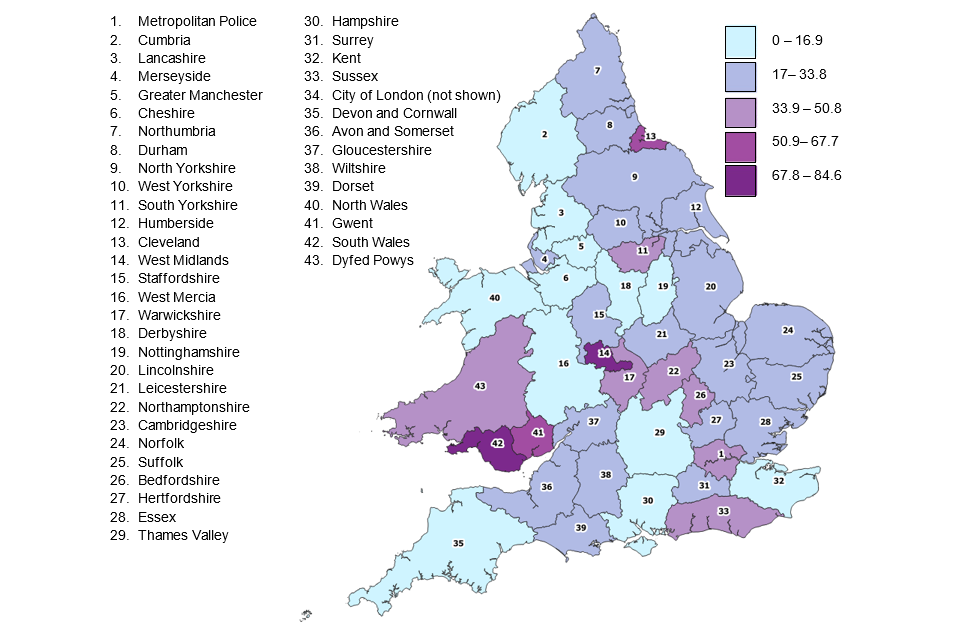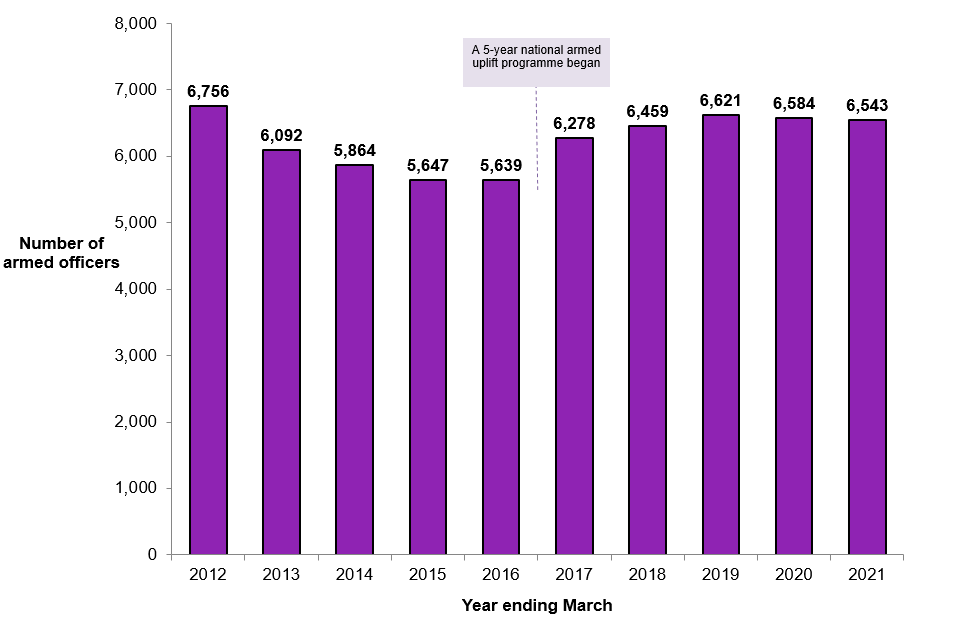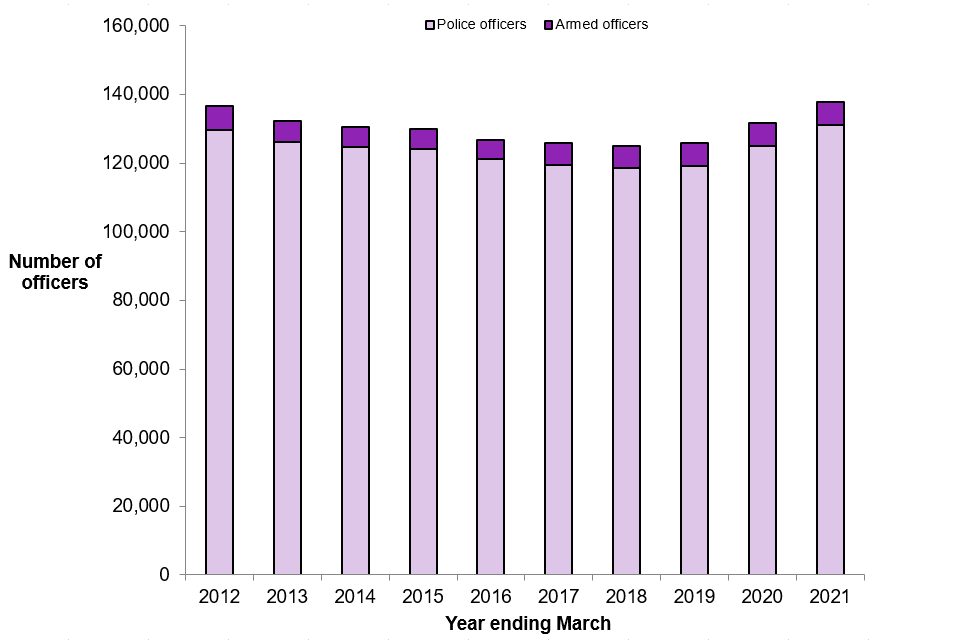Police use of firearms statistics, England and Wales: April 2020 to March 2021 second edition
Updated 3 February 2022
Applies to England and Wales
This release contains statistics on firearms operations and armed officer numbers in the year ending March 2021.
Frequency of release: Annual
Forthcoming releases: Home Office statistics release calendar
Home Office responsible statistician: Jenny Bradley
Press enquiries: pressoffice@homeoffice.gov.uk Telephone: 0300 123 3535
Public enquiries: PublicOrderStatistics@homeoffice.gov.uk
1. Summary
There were 18,262 police firearms operations in the year ending March 2021, a 6% decrease (-1,131) compared with the previous year and the second consecutive year-on-year decrease.
The two largest police forces, Metropolitan Police Service and West Midlands Police accounted for 34% of these operations.
Of the 18,262 operations, 92% (16,713) involved an Armed Response Vehicle (ARV), a similar proportion compared with the previous year (91%). There has been a gradual increase in the proportion of operations involving ARV’s since records began in the year ending March 2009 (81%).
There were 4 incidents in which police firearms were discharged. This compares with 5 incidents in the previous year.
There were 6,543 armed officers as at March 2021, a 1% decrease (-41) compared with the previous year. A similar decrease (-37) was also seen in the previous year. The total number of armed officers includes those operationally deployable as of March 31st 2021. This excludes officers who were absent due to sickness, those on paid leave, and those who were isolating due to COVID-19.
1.1 Impact of COVID-19
On 11 March 2020, the World Health Organisation (WHO) declared that COVID-19 was a global pandemic. A range of restrictions relating to COVID-19 began on 12 March 2020.
Evidence shows that there was a reduction in crime and offending at the height of the pandemic across England and Wales. Year-on-year comparisons of police firearm operations for the year ending March 2021 may in part reflect these reductions.
2. Introduction
This release contains statistics on police use of firearms from the 43 Home Office police forces in England and Wales, during the year ending March 2021. It details the total number of:
- Police firearms operations, including operations involving armed response vehicles (ARVs)
- Incidents in which police firearms were intentionally discharged at person(s)
- Authorised Firearms Officers (AFO)
Related Police use of firearms statistics data tables include figures for the years ending March 2009 to March 2021.
The ‘Police use of firearms’ release is an Official Statistics output produced to the highest professional standards and free from political interference. It has been produced by statisticians working in the Home Office Analysis and Insight Directorate in accordance with the Home Office’s ‘Statement of compliance with the Code of Practice for Official Statistics’ which covers our policy on revisions and other matters. The Chief Statistician, and the Head of Profession for Statistics, reports to the National Statistician with respect to all professional statistical matters and oversees all Home Office Official Statistics products with respect to the Code of Practice, being responsible for their timing, content and methodology.
3. Police firearms operations
3.1 Key results
In the year ending March 2021, there were 18,262 police firearms operations in England and Wales, a 6% decrease of 1,131 from the previous year. Of the 18,262 incidents, 92% (16,713) involved an ARV as the first or sole response.
Figure 1: Police firearms operations, including operations where an ARV was the first or sole response, England and Wales, years ending March 2012 to March 2021

Chart notes:
Source: Home Office, Police use of firearms statistics, data tables, Tables 1 and 2.
Notes: Percentage figures indicate the proportion of total police firearms operations where an ARV was the sole or initial response for each year.
As shown in Figure 1, the total number of operations are now at their lowest level in four years. The latest decrease may in part reflect the affect that restrictions in place during the COVID-19 pandemic had on crime and offending during this period.
Data collection note There are certain types of operations that are excluded from the data collection and will not be reflected in the charts. Please see Section 7.3 for the full list of excluded operations.
Since the year ending March 2017, the proportion of operations involving ARVs has increased in each of the last four years. ARV operations as a share of total armed operations have risen by 8 percentage points over the last five years. Additionally, in the year ending March 2021, 92% (16,713) of all firearms operations involved ARVs, which is the largest proportion since the time series began in the year ending 2009.
Armed Response Vehicles (ARVs) ARVs are vehicles adapted to accommodate specialist equipment and enable firearms officers to be transported swiftly to deal with incidents.
3.2 London and West Midlands regions continue to have the most police firearms operations
In the year ending March 2021, the London region had the largest proportion of all police firearms operations, accounting for around 1-in-5 (21%; 3,866) of the total operations. The West Midlands region had the second highest number of police firearms operations, accounting for 18% (3,225) of total operations. These two regions also accounted for the highest number of operations in the year ending March 2020.
The London region’s total operations fell 10% (-414), making this a three-year downward trend. The West Midlands region also showed a decrease in total operations, falling 4% in the year ending March 2021.
Figure 2: Total police firearms operations by region, England and Wales, years ending March 2020 and March 2021

Chart notes:
Source: Home Office, Police use of firearms statistics, data tables, Table 1.
The North East region showed the largest increase in police firearms operations at 19% (+133), although this region also had the lowest number of operations, so numbers do fluctuate year-on-year. The increase was driven by an increase of 104 (+151%) operations in Durham police force area. The largest percentage decrease occurred in the East Midlands region, which had 270 fewer operations (down 22%).
3.3 Highest number of operations reported by the Metropolitan Police
The police forces with the highest number of police firearms operations in the year ending March 2021 were the Metropolitan Police Service (3,771) and West Midlands Police (2,477). Together these forces accounted for 34% of all operations in England and Wales.
Figure 3: Total police firearms operations per 100,000 population by police force area, England and Wales, year ending March 2021

Chart notes:
Source: Home Office, Police use of firearms statistics, data tables, Table 1.
Population figures source: Office for National Statistics. Shape file source: ONS Geo-portal.
Notes: City of London is not included as its mid-2019 population estimate is less than 100,000.
4. Incidents in which police firearms were discharged at person(s)
These figures refer to incidents in which police firearms were intentionally discharged at person(s). The number of incidents do not reflect the number of firearms that were fired, or the number of shots fired.
In the year ending March 2021, there were 4 incidents in which police discharged firearms. Table 1 shows that this is the lowest number of incidents since the year ending March 2014. This represents 0.02% of total operations.
Table 1: Number of incidents in which police firearms were discharged, England and Wales, years ending March 2012 to March 2021
| Year ending | March 2012 | March 2013 | March 2014 | March 2015 | March 2016 | March 2017 | March 2018 | March 2019 | March 2020 | March 2021 |
|---|---|---|---|---|---|---|---|---|---|---|
| Number of incidents | 4 | 3 | 3 | 6 | 7 | 6 | 8 | 13 | 5 | 4 |
Table notes:
Source: Home Office, Police use of firearms statistics, data tables, Table 4.
Figures cover the number of incidents where conventional firearms were discharged. The figures exclude less-lethal weapons such as C.E.D. (Taser®).
Excludes accidental discharges, discharges for animal destruction, the use of firearms during police training and tyre deflations.
Following a data quality exercise, the number of incidents for the year ending March 2014 has been revised down from 4 to 3 incidents. Please see Section 6 for the full list of revisions.
5. Armed officers
5.1 Key results
In the year ending March 2021, there were 6,543 armed police officers, a 1% decrease (-41) compared with the previous year.
5.2 Number of armed officers shows small decrease for the second year in a row
This is the second consecutive year that the number of armed officers has shown a small decrease (-37; -1% in the previous year). Previous increases in armed officers are likely to be linked to the five-year armed officer uplift programme announced on 1 April 2016. The number of armed officers includes only those who were operationally deployable on 31 March 2021. This excludes officers absent due to sickness, those on paid leave, and those who were isolating due to COVID-19.
Despite recent decreases, the total number of armed officers is 16% higher than prior to the armed officer uplift programme.
Figure 4: Number of armed officers, England and Wales, as at March 2012 to March 2021

Chart notes:
Source: Home Office, Police use of firearms statistics, data tables, Table 3.
5.3 Proportion of armed officers to unarmed officers remains stable
As at March 2021, there were 137,704 police officers in England and Wales, an increase of 5% (+6,128) compared with the previous year. This continues the increase seen in the previous year of 5%. These increases are likely to be linked to the police officer recruitment drive announced on 5 September 2019. The proportion of armed officers to unarmed officer has remained stable over the last 5 years, averaging at 5%. There was a fall of -0.2% in the proportion of armed officers to 4.8% as of March 2021.
Figure 5: Total number of police officers and armed officers, England and Wales, as at March 2012 to March 2021

Chart notes:
Source: Home Office, Police use of firearms statistics, data tables, Table 3; and Police workforce open data tables, Table U1.
Notes: The number of police officers is a head count for full time equivalents (FTE). See Home Office, Police workforce open data tables, Table S2.
Chief Officers are expected to determine the number of armed officers in their areas based on a thorough assessment of threat and risk.
6. Revisions
During the data confirmation exercise carried out with police forces for the current release, a small number of forces submitted revisions to previously published data. These figures have been revised in the latest release in line with the revisions policy as set out in the Home Office Statement of compliance with Code of Practice for Official Statistics. Table 2 details these changes.
Table 2: Revisions to figures published in year ending March 2020 release
| Financial year | What was revised | Number of forces that made revisions | Previously published figures (in 2019-20 release) | Revised figures (in 2020-21 release) | Numerical change | % change |
|---|---|---|---|---|---|---|
| 2013-14 | Number of incidents | 1 | 4 | 3 | -1 | -25% |
| 2019-20 | Police firearms operations | 2 | 19,372 | 19,393 | +21 | +0.1% |
| 2019-20 | Police firearms operations involving ARVs | 3 | 17,687 | 17,707 | +20 | +0.1% |
| 2019-20 | Number of armed officers | 8 | 6,518 | 6,584 | +66 | +1% |
Table notes:
Source: Home Office, Police use of firearms statistics, data tables, Table 1, 2 and 4.
Previously published figures from Home Office, Police use of firearms statistics data tables, Table 1, 2 and 4.
Figures for percentage change are rounded to 1 decimal place, see rounding.
The data for the latest year (and for previous years) may be revised in due course. It is standard practice across all Home Office statistical releases to incorporate revisions for previous years’ data in the latest release.
7. Quality and methodology
7.1 Data quality
During the data collection process, Home Office statisticians discovered a possible discrepancy in the reporting of the total number of armed officers.
During the data collection process, an inconsistency in the number of armed officers reported was identified for a small number of police forces. These police forces resubmitted their data to include all Specialist Firearms Officers and Counter-Terrorist Specialist Firearms Officers in their total armed officer headcount. This led to an upwards revision of 70 armed officers in the year ending March 2020 figures.
The identification of this inconsistency has helped to improve the accuracy of the data included in the year ending March 2021 publication, but it remains possible that there are small inaccuracies in years prior to the year ending March 2020. Guidance for police forces will be refreshed to improve consistency in reporting.
7.2 Data assurance
These statistics are compiled by statisticians within the Home Office. They undertake a wide range of quality assurance checks and work closely with all 43 police forces with regular contact as needed. These checks follow the QAAD guidance (Quality Assurance of Administrative Data) and include:
- Variance checks, i.e. investigating substantial changes in figures compared with the previous year
- Including safeguards within the return to improve data quality
- Ensuring all returns are accounted for, and that no duplicate returns are provided
- Querying incomplete or invalid data and invalid combinations of data, provided in returns
- Explaining to users about the data quality and the impact upon the statistics
7.3 Data collection
The statistics in this release are based on aggregated figures for the year ending March 2021 submitted by the 43 territorial police forces as part of the Annual Data Requirement (ADR). The ADR is a list of all mandatory data requests made to police forces in England and Wales under the Home Secretary’s statutory powers.
As with previous releases, a data confirmation exercise was carried out by Home Office statisticians with the support of police forces. Validation and variance checks were carried out on the data as part of the quality assurance process. This reduces the risk of publishing incorrect figures.
The total number of operations involving the authorised deployment of armed officers excludes:
- Operations where officers were stood down before being deployed
- Armed officers deployed for VIP protection, armed prisoner escorts, airport patrols, other guarding duties and routine patrols
- Firearms operations involving accidental discharges, discharges for animal destruction, during police training, or to deflate tyres
- Operations where the reporting police force did not issue an authority but assisted another police force on an operation. The authorising police force would submit data relating to this operation, eliminating double counting
The total numbers of police firearms operations include all operations involving ARVs. The number of operations involving ARVs is a sub-category of all police firearms operations in which the initial or sole response was by an ARV.
Figures for incidents where firearms were discharged cover the number of incidents where police discharged conventional firearms. The figures exclude discharges of less-lethal weapons, incidents involving accidental discharges, discharges for animal destruction, during police training, or to deflate tyres.
The number of armed officers incorporate all armed officer roles (including ARV officers, Specialist Firearms Officers and Counter-Terrorist Specialist Firearms Officers), as well as those currently being utilised as trainers or deployed in non-firearms roles.
7.4 Changes to the data
Publications prior to ’Police use of firearms statistics, England and Wales: April 2016 to March 2017’ included the number of ‘Authorised Firearms Officers’ (AFOs). An AFO was defined as “a police officer who has been selected, trained, accredited, and authorised by their Chief Officer to carry and use a firearm”. Following feedback from the National Police Chiefs’ Council (NPCC), College of Policing, and police forces, the publications for the year ending March 2017 and onwards includes the number of ‘armed officers’.
This change was implemented to increase clarity, as the term ‘AFO’ can be used to refer specifically to an armed officer trained at the basic level, as well as to any armed officer in general. The change accounted for less than 0.5% of the total number of armed offers as at 31 March 2017. As such, the figures for 31 March 2017 and onwards are regarded as comparable with figures from previous publications.
7.5 Comparability of the data
While data from the year ending March 2002 onwards are available, the figures were not subjected to the same rigorous data validation or variance checks that have been applied to the data since. Therefore, the quality of these figures may not be of the same standard, making them incomparable with data from later years.
This is the fifth year that information relating to the number of incidents in which police firearms were discharged has been collected as part of the ADR, confirmed and published. Previously, the data on incidents involving discharges were supplied by the NPCC who collected the information from forces. This was not a mandatory requirement, and the figures were not quality assured in the same way that the discharge data collected via the ADR have been. With this in mind, figures for the years ending March 2002 to 2008, which include police force level breakdowns, can be accessed online.
The ‘Police use of firearms statistics, England and Wales: financial year ending March 2014’ release detailed some of the quality assurance work that took place for previous years, including data confirmation by Chief Officers for all data covering the period from the years ending March 2009 to 2014.
7.6 Rounding
Data are provided unrounded in the data tables accompanying the ‘Police use of firearms, England and Wales’ publication. This is to promote transparency and allow users to exploit the data further. Unless specified within the notes for the table, percentages in the release are rounded to the nearest % using the round-half-away-from-zero method. For example, 23.5% will be rounded to 24%, and -23.5% will be rounded to -24%. Percentages under 1% are rounded to the nearest significant figure.
Where data are rounded, they may not add up to the totals shown, or, in the case of percentages, to 100%, because they have been rounded independently.
8. Glossary
Armed response vehicle (ARVs) – ARVs are police vehicles carrying armed officers trained to the ARV standard. These vehicles are crewed by uniformed officers who have been selected and trained to respond to a range of armed operations involving subjects on foot, in moving vehicles and in buildings. ARVs are adapted to accommodate specialist equipment and enable firearms officers to be transported swiftly to deal with ongoing incidents.
Armed officer – This refers to officers authorised to carry and use firearms, which should incorporate all armed officer roles (including ARV officers, Specialist Firearms Officers and Counter-Terrorist Specialist Firearms Officers), as well as those currently being utilised as trainers or deployed in non-firearms roles. For more information please visit the College of Policing website.
Attenuating energy projectile (AEP) – An AEP is a soft-nosed impact projectile fired from a single shot launcher. AEP is a form of less-lethal weapon only available to authorised officers who have been specially trained in its use. This gives specially trained officers an additional means of dealing with threats of serious violence. It delivers an impact that is not intended to cause serious or life-threatening injury but is of sufficient force to dissuade or prevent a violent or potentially violent person from their intended course of action, thereby reducing the threat.
Firearm – This includes any conventional firearm routinely deployed by firearms officers. This does not include less-lethal weapons such as AEPs and Conducted Energy Devices (CED) i.e. TASER®.
Police firearms operations – Police firearms operations involve the authorised deployment of armed officers where they may have to protect themselves or others from a person who: (a) is in possession of a firearm or other weapon; (b) has immediate access to a firearm or weapon; or (c) is otherwise so dangerous that the officer’s use of a firearm may be necessary.
Each operation is counted as only one operation regardless of the number of personnel (or deployments) or tactics employed, or the number of rounds discharged.
Police firearms operations involving ARVs – Police firearms operations in which an ARV was the initial or sole response are counted in this category. Police firearms operations in which ARVs were deployed as a secondary response would be counted in police firearms operations.
9. Uses of the statistics
Uses of the statistics on police use of firearms are listed using the standard categorisation for official statistics.
a) Informing the general public’s choices
-
About the state of the economy, society and the environment – figures on police use of firearms are used by the media in articles on police use of force
-
About the performance of government and public bodies – figures on levels and trends in police use of firearms are requested via Parliamentary Questions and Freedom of Information Act requests to gauge performance in general or specific areas
-
When officers take the difficult decision to deploy force it is vital that they can be scrutinised by the people they serve
b) Government policy making and monitoring
Police use of firearms statistics are used to monitor the operational performance and effectiveness of police forces, and to inform government policy and decisions by ministers. The statistics provide a national and regional level picture of armed policing, giving some insight into how public money is spent to resource policing capabilities and the UK’s capacity to deal with serious incidents.
c) Resource allocation – typically by central and local government
Policing statistics, including statistics on police use of firearms, demonstrate the range, extent and quality of police activities, and contribute to overall cases for police funding.
10. Related statistics and feedback
Releases in this series
Forthcoming publications are pre-announced on the GOV.UK website research and statistics page.
‘Police use of firearms, England and Wales’ statistical releases for the year ending March 2008 onwards are available from the Home Office pages of the GOV.UK website.
Figures for the years ending March 2002 to 2008 are also available online.
Police use of force
Statistics on Police use of force were published on 17 December 2020, and included the use of firearms as a tactic in incidents. A use of force incident differs in definition to police firearms incidents included in this release, as they represent each time an officer uses force on an individual, rather than specific events.
The use of force statistics include other data relating to firearms incidents such as location, incident outcome, reason for using force, and further subject details such as age, ethnicity, and gender. The two collections cannot be linked and it is not possible to identify specific firearms operations within use of force incidents.
Feedback and enquiries
We are always looking to improve the accessibility of our documents. If you find any problems, or have any feedback, relating to accessibility, or general questions regarding this publication, please email us PublicOrderStatistics@homeoffice.gov.uk.
